
OutToPlayJazz
-
Posts
4,216 -
Joined
-
Last visited
Content Type
Profiles
Forums
Events
Shop
Articles
Posts posted by OutToPlayJazz
-
-
Thanks Mart - Yes, the Corvette $$ is quite suitable for jazz. The twin humbuckers which can be switched between parallel and series, etc. have an infinite quantity of sounds. On the other hand, if you want something softer and wollier sounding, have a go with the FNA Jazzman version of the 'Vette. That's a lovely bass for jazz gigs, but very expensive at around £1100 from most dealers.
As for people swapping out the MEC pickups, I think it's just a case of personal preference. I love the MEC sound, personally. Crisp and crunchy with a bottom end growl as well.
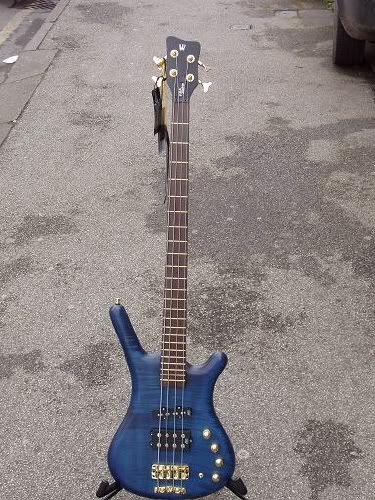
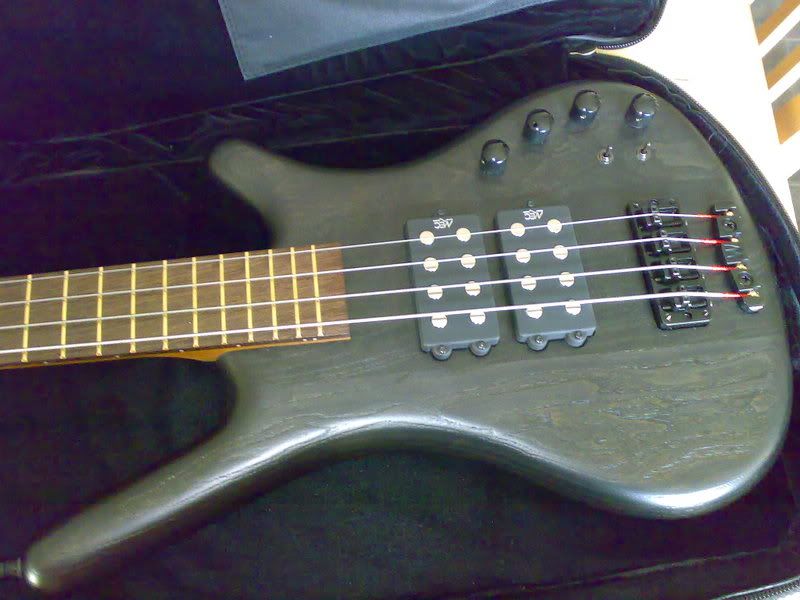
-
[quote]How do you find the ovangkol neck? I'm a big fan of maple and I find that of all the warwick's I've tried, it's been the ones with traditional wood combos (i.e. ash/maple) that I like the most.[/quote]
Mark, I love the ovangkol/wenge combination. It's very smooth and very fast. You mentioned that you'd tried the Double Buck Streamer, well the Corvette is a very similar sound and feel, only the neck is a bit thinner (in the all important thumb-fingers dimension!) Also, I personally think that the wider Corvette body balances better than the Streamer.
Rich. -
I'd vote for the bass cube 100, but the other one that sprang to mind was my old Marshall B65. Lovely sounding amp & still pretty portable. Or even an Ashdown EB180-12 or the 15 version.
-
That's a lovely looking bass... Quite fancy one like Tal Wilkenfeld's in the natural with the active circuit, etc. So you're a full-on Sadowsky-ite now, then?
-
I've got one of the Fender Platinum bass cables. It's pretty rigid & is claimed to eliminate signal loss due to a new design of sorts. It's covered in "steam iron" type cladding, so very stiff and easy to coil. Only downside is that it was £40.
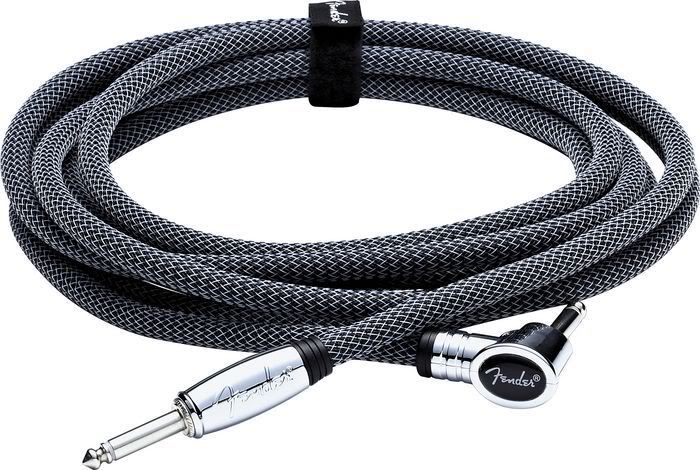
-
[quote]Chocolate finish you say? Were you looking at mine or Pyschoandy's GB Spitfire? I've already got one of those(!)[/quote]
Bloody hell! I was looking at your GB bass all along, mate! It's a lovely one, at any rate!
It's a lovely one, at any rate! -
My current one is a Geddy in... Yep, you guessed it! Black with maple 'board
 But my old jazz was a fetching MIM 5-er in Fender's lovely "Midnight Wine." Actually, come to think of it, there was a lovely GB Spritfire last week on the bass porn section in a fantastic transparent chocolate finish - Loveliest bass I've seen for ages!!
But my old jazz was a fetching MIM 5-er in Fender's lovely "Midnight Wine." Actually, come to think of it, there was a lovely GB Spritfire last week on the bass porn section in a fantastic transparent chocolate finish - Loveliest bass I've seen for ages!!
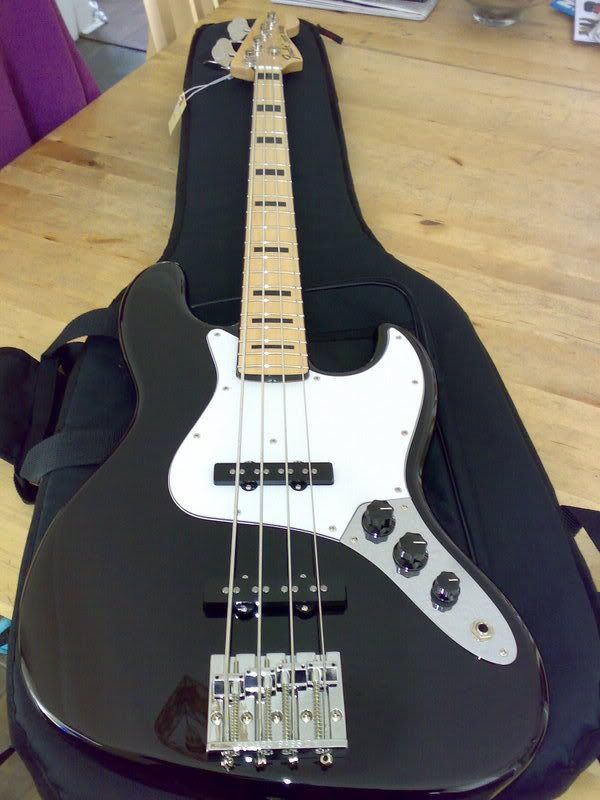
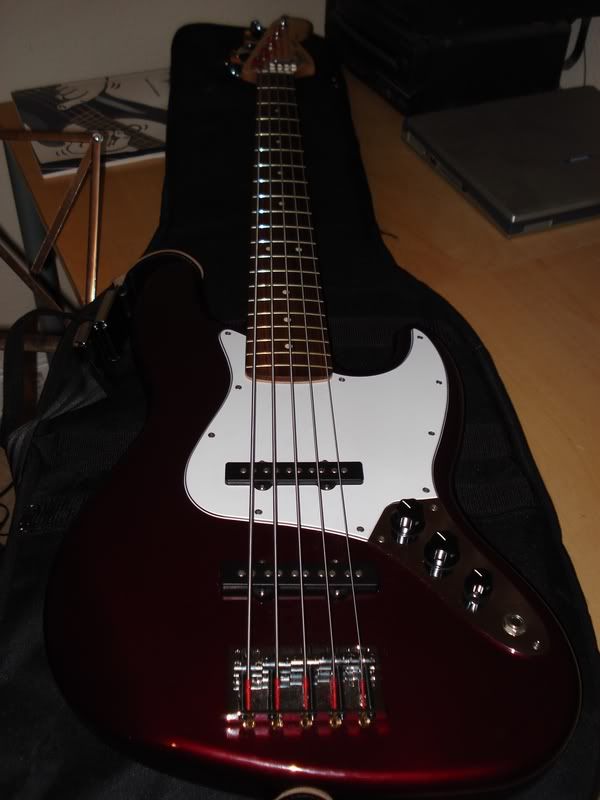
-
Hi guys & girls, was just wondering what lovely basses & other various gear you all received for Xmas?
I'll start the ball rolling with an Ashdown MAG 300 head unit that I'm using with my MarkBass 2x10 cabinet as a "baby rig"
-
[quote]OTPJ, hows that double buck working out for you?[/quote]
As a rock/funk bass I love it! Only complaint is a loss of output on the G-string, but that could be how I've got it set up. It's a fantastically fast bass to play & has a general sound that I can only liken to that of God shouting!!! -
I was thankfully GAS free for many-a-year (about 16, actually!) and I bimbled around playing my 1988 Status S2 through a Trace 15 combo with a 4x5 bright box on top. That never really changed for a very long time. Now I guess I'm wealthier & go through phases...
After I got my KingBass, I got the urge to get another 5-stringer... An MIM jazz, which was a beautiful bass in all apart from the poor output. I then went through a plethora of bargain buys & several basses passed through my mitts in the space of about a year!
Fender Jazz V MIM, Status Groove, Squier 70's VMJ, Jackson CMG concert bass, Ibanez SRX-705, etc, etc...
I've now got some non-Status basses that I really like and play a lot... Warwick Corvette $$, Fender Geddy Lee CIJ, Yamaha TRB-6, etc. Now all my basses have a specific job & I don't have anything surpluss.
I've just got my new Status S2-classic & have another KingBass on order for 2008, but that's because no matter what you may see me playing out and about, I'll always be a Status player at heart. So in answer to the question, given a choice, I'd give all my hard earned to Rob Green in Colchester so he could make me a fabulous collection of basses
-
Yes, I think it was around that. I ordered it through a friend's shop on this occasion & it came to something like £195 inc. carriage. But as Damien says, you can get them cheaper if you shop around.
-
Playing-wise, there's no difference at all. This is a case of what's called "Enharmonic Equivalents". Ie., two notes (or in this case, keys!) that are written differently, but sound the same.
The key of Gb Major has six flats & F# Major has six sharps. So they look very different on paper, but playing-wise they're identical.
So if you were thinking you could get away with learning just one scale for the two keys, you were absolutely right!!! -
As stated above, every note within any given key has a technical name, as below.
C Major
1st C Tonic
2nd D Supertonic
3rd E Mediant
4th F Sub Dominant
5th G Dominant
6th A Sub Mediant
7th B Leading Note
8th C Tonic (Octave)
These are all the notes in the key of C Major, but every key has the same names attached to it's particular notes, so for example, the sub dominant note in A Major would be D.
The terminology of a "dominant 7th" describes a 7th chord (eg. GBDF in C Maj) based upon the 5th note in the scale of the given key.
As 7string very ably explained, the subdominant is the major chord based upon the 4th note of the scale. (eg. FACF in C Maj.) -
[url="http://basschat.co.uk/index.php?showtopic=10187"]http://basschat.co.uk/index.php?showtopic=10187[/url]

-

The Squier "Pete Wentz" signature Precision is possibly the most un-precision like precision I've ever played. I guess that's why I like it! For those of you not in the know, Mr.Wentz plays for an American band called "Fall Out Boy", which involves some quite harmless pop music, but quite a lot of jumping around on stage for no apparent reason - Am I being too reserved & British here?
It has a jazz bass neck (ie., thinner & faster than the standard precision item) in natural satin maple and a Seymour Duncan-designed twin pickup set which gives decent output across all four strings. Having tried and been a little underwhelmed by the SD design jazz pickups in the Squier Vintage Modified 70's jazz bass, the P-style double pickup in the Wentz bass is a revelation. Truly growly, but with strong, even tone. Sounds exactly how you'd want a passive bass to sound - ie., not making you wish you'd brought an active bass out with you!
The bass is light and balances well on the knee, and there's no reason it won't perform equally well on the strap. The jazz neck is, I believe *correct me if I'm wrong!*, the same model as used on the VMJ. Even for a jazz neck, this is ultra fast & very comfortable in the hand, feeling as though it would be just as comfortable after two straight hours of playing on stage.
Playing quite hard and vigourous finger stlye, the bass is both fast and reassured, and you often forget that you're not playing a much more expensive instrument! This seems to be something that Squier are getting very good at these days. The current range of Squier basses never seems to feel cheap or built down to a price as such. Slap style playing also sounds great on the Wentz, with more of a bass frequency thump than you'd get on a jazz. Overall, the sound is very well balanced. The bass was tested first briefly through a 35w Kustom keyboard amp, and then later on an old Trace Elliott Boxer 65 at one of my schools.
There's really very little to say about the control set on this instrument - It only has one control, a single volume pot. The tone frequency really doesn't need moving at all, as the bass sounds so good, anyway!
As for the looks, this is going to be a Marmite bass of sorts... The all black gloss body with the red tort-style pickguard is very fetching, as is the maple neck. But the huge "bat/heart" graphic on the edge of the body is just too much! It would be nice if Squier could offer this as an option, the same as you're often able to delete badges on certain car brands! The same goes for the bat/diamond decal at the 12th fret on the fingerboard. Thankfully, this one is a little more subtle on the eye!
All in all, this is a great value for money bass which packs a serious punch & mixes it with simple ease of playing. The one I ordered for a pupil really impressed me & the other one I have on hold for someone else may even make it into my own collection for a while. If only I could delete that bloody red bat-heart graphic! -
Stunning looking bass, Andy - Congrats

-
Yes, lovely sound, although I liked the original bass player better... Stuart Zender, was it? What basses did he play?
-
I actually rather liked it - I was just offered a lot more money than I paid for it at the right time. Once I'd put on the spare set of rotosound 30-115's, it sang! We'll see how Mick in Switzerland gets on with it

-
Indeed... It's left the BC fold, I'm afraid. In fact, possibly the shortest time I've ever had a bass!
The statii member contacted me the other day asking if I still had my KingBass 5 for sale. I told him I'd sold it, had bought a new replacement S2 & just picked up an Energy Artist 5 with a replacement graphite neck. He offered me a price I couldn't refuse for the energy
I think this is called "trafficking" in certain countries
-
Anything with a Status badge on it and a nice shiny graphite neck... Like this one

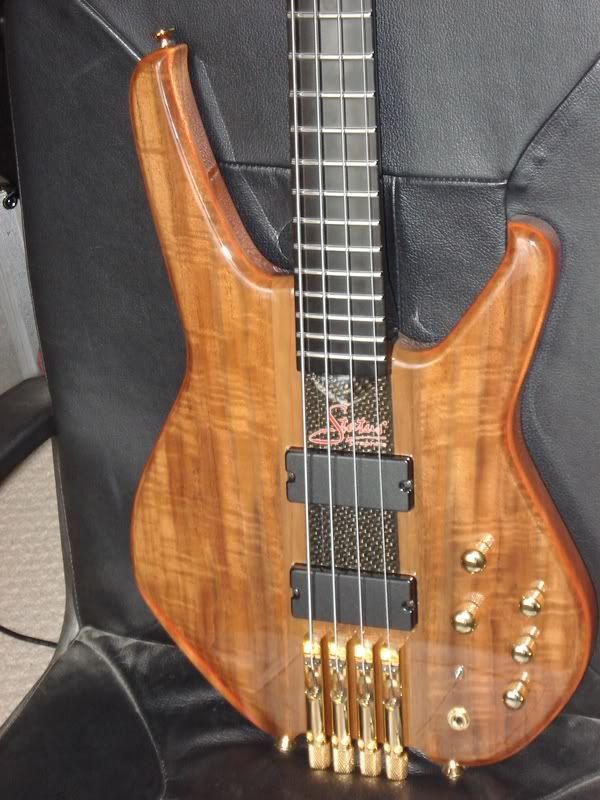
-
I like the fact that the HWone has the Badass bridge as standard & the graphite neck poles, but I'm not convinced by the nitro "wears out fast" finish. On the other hand, the S1 switching & through body stringing gives you more sound options with the MIA standard. But all in all, the finish on either isn't great. You only have to look at a CIJ Fender like my Geddy Lee. It makes all the American ones look and feel shoddily made. I'd go to one of the Japanese importers & get one of the 75 reissues with the badass bridge and save some money compared with an MIA.
I played yet another current MIM jazz at Sound Control last weekend. Amazing sounding and playing bass. Make sure you play one of the current Mexicans before you shell out a lot of money! -
Hi there guys,
Got a cancelled Christmas order for sale... Ashdown EB180-12 combo, brand new in box. Pickup only, due to weight. If interested, either PM me or call Richard on 07946 513119. -
#131
+9
=734 -
Hmmm... That's a tough one, mate. I'd make daughter #1 get a part time job and work her way through college, like the rest of us had to!


.jpg.518c69c2d9e1581799f3c11301dc2da5.jpg)
What's the difference in the sound?
in General Discussion
Posted · Edited by OutToPlayJazz
Here's what Rob Green from Status-Graphite says about Ash as a tone wood... (Obviously discount the bit about the graphite neck!)

[quote]Ash bodies are medium density and weight. The timber produces a clear tone with plenty of definition. When combined with the graphite neck this bass is great for percussive playing. The wood has an open grain and a light colour with darker features.[/quote]
... And from A musician’s guide to choosing tonewoods by Paul Woolson...
[quote]Bubinga is quickly becoming a favorite wood with custom builders, and may soon find its way into large production shops. This wood, which comes from Africa, has a tremendously rich sound replete with warm even tones and a brilliant sparkle across the entire spectrum. It is plentiful and available in a wide variety of cosmetic appearances. Typically Bubinga has a mottled "bees-wing" appearance under finish that is absolutely gorgeous, and also can be acquired with strong ropey curl.[/quote]
I'd imagine the Bublinga instrument would have a warmer sound that the much brighter ash-based one